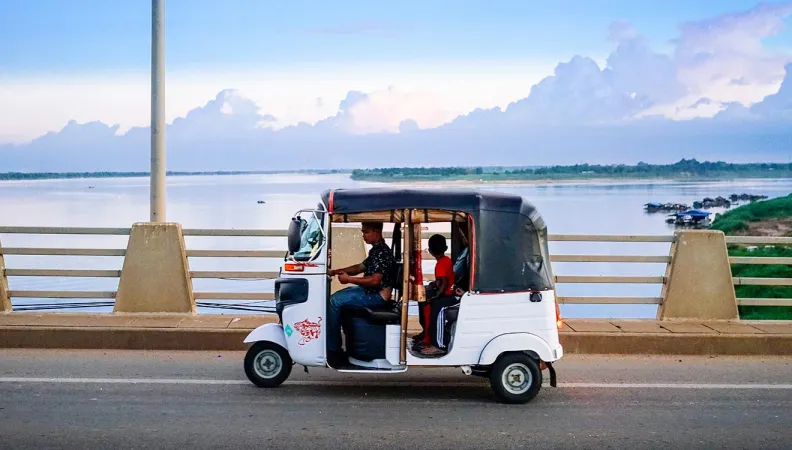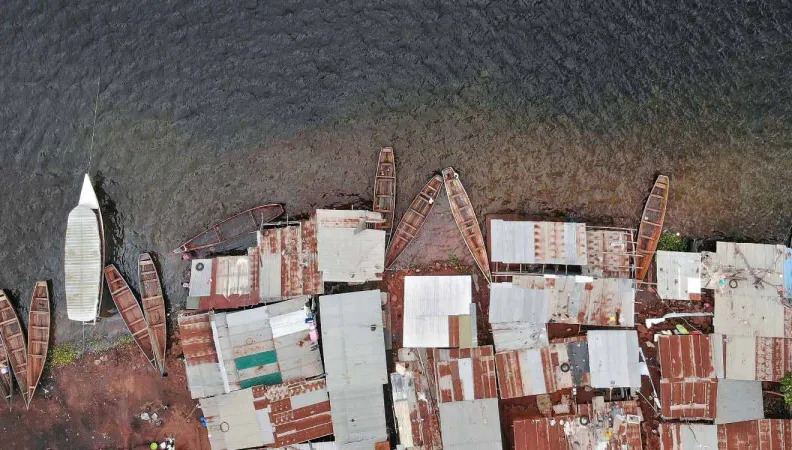 The content of this project information sheet falls under the sole responsibility of the AFD and does not necessarily reflect the opinions of the European Union.
The content of this project information sheet falls under the sole responsibility of the AFD and does not necessarily reflect the opinions of the European Union.This project is carried out with the support of the European Union
 Legal notice EU (project) The CEQ Assessment is a tool that analyzes the impact of taxation and social spending on inequality and poverty, allowing governments to assess the redistributive and poverty-reduction impact of their fiscal policy.
Legal notice EU (project) The CEQ Assessment is a tool that analyzes the impact of taxation and social spending on inequality and poverty, allowing governments to assess the redistributive and poverty-reduction impact of their fiscal policy. In the first phase of the project (2018-2020), Agence Française de Développement (AFD) and the Global Development Network (GDN), in partnership with the Commitment to Equity (CEQ) Institute as well as local universities and local authorities, joined forces to implement the CEQ assessment in four African countries: Morocco, South Africa, Cameroon and Kenya.
In order to document its five-year planning process, Senegal requested the support of AFD and GDN to study the impact of fiscal and social reform scenarios. A second phase of the project, focusing on Senegal but also on methodological issues, is thus taking place over the 2023-2024 period.
Context
In the first phase of the project, Morocco, South Africa, Cameroon and Kenya were selected to participate in the research, analysis, and policy recommendations program, which significantly enhanced the evidence base for efficient and thoughtful redistributive fiscal policy that protects poor and vulnerable households from further impoverishment. Each of these countries learned from, and in some cases incorporated, the successful programmatic experiences from the others. The work program that the AFD-CEQ partnership encompasses also promoted skills sharing and capacity building between countries.
This project was part of the first phase of the Research Facility on Inequalities, coordinated by AFD and funded by the European Union over the 2017-2020 period. The first phase of the Facility has led to the conduct of 22 research projects and the publication of around 100 research papers and policy briefs.
Part of the second phase of this project focuses on Senegal, which is facing a number of important, sometimes contradictory challenges, likely to bring about lasting changes to the social contract and the redistribution of national income, such as:
- the development of gas and oil deposits (and the collection of the associated tax revenues),
- the implementation of a just energy transition partnership (JETP), which at the same time calls for the decarbonisation of growth,
- the desired extension of social protection schemes (health, retirement) to accompany a demographic transition that is still underway,
- the dismantling of energy subsidies to finance more infrastructure and develop better-targeted subsidies for poor households.
There is strong social demand for policies to reduce inequality, but this is taking place against a backdrop of regional instability, increased conflict, global inflation and global warming.
This analysis will be conducted in partnership with the Directorate General of Planning and Economic Policies of the Senegalese Ministry of Planning and the World Bank.
Objectives
The development of the CEQ Assessments, which are the centerpiece of the AFD-CEQ Institute partnership, accomplish two major objectives simultaneously:
- The implementation of CEQ Assessments builds an empirical evidence base (country by country) of the redistributive and poverty-reduction impact of fiscal policy broadly, as well as of individual fiscal elements (revenues or expenditures).
- The implementation of CEQ Assessments together with local research teams completes a knowledge and skill transfer to researchers and policy officers who will remain close to the ongoing policy debate and policy-making bodies who benefit from having this information at their disposal.
The AFD-CEQ Institute partnership therefore leaves in place the basic human infrastructure necessary for additional fiscal incidence analysis, including forward-looking policy simulation.
As part of the second phase of the project, the aim is for Senegal to master the CEQ tax incidence analysis tool and study a series of pro-poor reforms to reduce social and/or regional inequalities.
The expected deliverable is a report quantifying the impact of 5 areas of reform (cost, effects, financing).
Method
The CEQ Assessment is a comprehensive and rigorous tax and benefit incidence analysis which enables to have an active engagement with the policy community.It is designed to address the following four questions:
- How much income redistribution and poverty reduction are being accomplished through fiscal policy?
- How equalizing and pro-poor are specifics taxes and government spending?
- How effective are taxes and government spending in reducing inequality and poverty?
- What is the impact of fiscal reforms that change the size and/or progressivity of a particular tax or benefit?
In order to address these questions, experts from the CEQ working along with AFD researchers and local researchers teams implemented the CEQ methodology in Morocco, South Africa, Cameroon and Kenya, and will do so in Senegal.
Once done, the objective is to mainstream the use of CEQ Assessments:
- By reaching out to the policy community through partnerships and policy forums;
- By disseminating findings through an active communication and advocacy program, undertaken in conjunction with key partners in the research, philanthropic and social activist communities.
Results
You can find below the various publications related to this research project.
Fiscal incidence analysis reports:
- Fiscal incidence, inequality and poverty in Kenya: a CEQ assessment
- The impact of taxes and transfers on poverty and income distribution in South Africa 2014/2015
- Les effets de la politique budgétaire sur la pauvreté et les inégalités au Maroc (in French)
Policy briefs:
- Fiscal Incidence and Public Spending: Public Policy Scenarios for Colombia (January 2024)
- Distributional Impact of Fiscal Policies: A Survey of Methodological Approaches (October 2024)
- Analyse de l’incidence de la fiscalité et des dépenses sociales sur la pauvreté et les inégalités au Sénégal (January 2025, in French only)
Contacts
-
Anda DAVID
Economist, scientific coordinator of the EU-AFD Research Facility on Inequalities

-
Emmanuel FOURMANN
Research Officer

 Legal notice EU (project) This project proposes a systematic analysis of the inequality-environmental change nexus in the Lower Mekong River Basin Region. It aims at building scientific base for policy action as well as identifying uninvestigated research questions. In addition, case studies on relevant fields in Vietnam, Cambodia, Laos and Thailand, representing existing or ongoing researches undertaken by the research network (WANASEA - "Strenghten the Production, Management and Outreach Capacities of Research in the Field of WAter and NAtural Resources in South-Est Asia" - and IRD) will form a collective book on the topic, together with the systematic review.
Legal notice EU (project) This project proposes a systematic analysis of the inequality-environmental change nexus in the Lower Mekong River Basin Region. It aims at building scientific base for policy action as well as identifying uninvestigated research questions. In addition, case studies on relevant fields in Vietnam, Cambodia, Laos and Thailand, representing existing or ongoing researches undertaken by the research network (WANASEA - "Strenghten the Production, Management and Outreach Capacities of Research in the Field of WAter and NAtural Resources in South-Est Asia" - and IRD) will form a collective book on the topic, together with the systematic review.
Contexte
Mekong River Basin is crucial for the livelihoods of millions of people of six countries: China, Myanmar, Lao PDR, Cambodia, Thailand, and Vietnam. The last four countries are categorized as the Lower Mekong Basin, where two thirds of the population relies on the water resources for subsistence agriculture and fisheries as well as to develop other activities such as transport and tourism. The current anthropogenic causes for environmental degradation in the region include the construction of dams, over-extraction of underground water, pollution from fast developing cities, deforestation, sand extraction, and other activities which create risks to human settlements that were even unheard of ten years ago. More often than not, the impacts of changes vary between groups of people and strongly informed by the social inequalities. Climate change adds to this ongoing environmental degradation by increasing the region’s fragility. For example, one meter of sea-level rise would cause displacement of 7 million inhabitants and flood the homes of more than 14.2 million people in the Mekong Delta.
These major anthropogenic degradations take place in a specific regional and global socio-political context. On the one hand, an accelerated rural transition has been pushed by national governments with the idea of integrating the agricultural sector into the global markets, but also under the pressure of global financial markets searching for returns in the aftermaths of the financial crisis. This rural transition occurs at a pace that fragilizes the economies when they cannot absorb the workforce in excess into the developing industrial or services sectors. In this respect, the Mekong region is a spectacular example of the economic and environmental consequences of the 2008 financial collapse on developing and emerging economies. On the other hand, the countries of the Mekong region are also subjected to the geopolitical shift putting China in the center of a new globalized system. Most of them contribute heavily to this new dynamics, which also severely impacts their environment and inequalities altogether.
For years, international and local organizations, South-East Asian governments as well as bilateral and multilateral development banks have been working to help the Mekong countries mitigate these impacts. However, the lack of a systematic review of existing knowledge in the Mekong makes it difficult to evaluate the impact of specific actions on inequalities and environmental quality. At a moment when governments (both regionally and globally) call for urgent actions, it is time to consider a systemic approach to the environment - inequality nexus in the region.
This project is part of the first phase of the Research Facility on Inequalities, coordinated by AFD and funded by the European Commission's Directorate-General for International Partnerships over the 2017-2020 period. The first phase of the Facility has led to the conduct of 22 research projects and the publication of around 100 research papers and policy briefs.
Objectif
Rising inequalities and accelerating environmental changes are two of the most significant challenges of the twenty-first century. But how do they relate to each other? Do they have common dynamic factors? This research project proposes a specific regional study on how these multidimensional variables of inequality and environmental changes relate and interact with each other. It aims at building scientific base for policy action as well as identifying uninvestigated research questions
Throughout the region, socio-economic inequalities relating to income, employment, education, access to land and other services, as well as demographic differences, such as age, gender, ethnic, and so on are more and more associated with unequal exposure to environmental risk factors. These factors can represent direct threats to people’s lives (landslides, flooding, etc.), or contribute, in an indirect way, to the degradation of agricultural land, propagation of diseases, or, more widely, health issues (air pollution, etc.). They often put already disadvantaged groups at significantly higher risk for environmental effects. Besides, the existing inequality might also contribute to the environmental changes.
Environmental risk factors considered in this project are not solely linked to global climate changes. They are also (and, for the moment, most often) the direct consequences of the growing pressure of human populations and the economic dynamics on the ecosystems. This is particularly visible throughout the Mekong River Basin. The Mekong region has been radically transformed in the last ten years by the pace and scale of large-scale land acquisitions through foreign and domestic investments leading to growing inequalities, rural unrest, and a process of simplification and commodification increasingly replacing traditional and natural systems. The spatial scope of analysis cannot thus remain purely national.
At this stage however, it seems difficult for the local or national decision maker, let alone any regional institution, to take science-based action, as long as no mapping of this scattered knowledge exists, highlighting the diverse quality of the studies, their data sources, their representativeness, the needs for further studies or on the contrary the well-established results. Scoping and systematic reviews, a technics initially coming from the field of medicine, can provide with such a dashboard instrument.
Beyond the project, an objective would be to build a research and capacities research project mobilizing the main academic and non-academic actors in the Southeast Asia region on the research directions which would have emerged from this systematic study.
Méthode
- Scoping the existing knowledge on inequalities and environmental change in the Mekong region
First, we will conduct a preliminary scoping review of the related scientific and grey literature on inequalities and environmental changes in the Lower Mekong region. The resulting literature and data repository created by the review can be of use to researchers and stakeholders interested in the topic. As such, it represents a scientific result and output that can be published in a first scientific paper. It also represents a crucial first step for the two co-implementing partners in the region, who represent a broad network of interdisciplinary researchers in the four countries of the Lower Mekong River basin, and who intend to develop broader research programs based on this scoping review.
- Building a dashboard for operational recommendations through a systematic review
Second, we will develop a systematic review. In this second step, quality filters apply, it involves data extraction as well as quantitative analysis. This step requires the work of a full time post-doc, helped by experts in the different fields represented in the scoping review, and possibly the help of documentalists from the different represented countries. It is thus crucial to be able to gather the expertise of a network of researchers and operational experts already working in the different dimensions of the subject. This is what the WANASEA network, combined with the IRD network in South-East Asia as well as experts from AFD in the region, the Mekong River Commission (MRC), the Compagnie Nationale du Rhône (CNR), the World Wildlife Fund (WWF), and the IUCN will allow to convey. This expert committee will commit to contribute a few days in the year to help the post-doctoral expert taken the right decisions in the filter of data, methods and papers.
- Integrating case studies illustrations in the general framework
As a third step of the project, we propose to develop four case-studies which would shed the light on different existing research programs which already studied some aspects of the relation between inequalities and environmental changes along the lower Mekong river basin, from Laos to Vietnam.
Résultats
The first results of the project will be presented for the international conference on “Climate impacts in South-East Asia” in Quy Nhon (Vietnam) in march 2020. They will lead two at least two research papers and a collective book.
The final results will be presented at the ASEAN Water Platform (WANASEA) in the summer 2020 in Chiang Mai University (Thailand).
Find the presentation of the research paper “Inequalities and Environmental changes in the Mekong region: a scoping review” by Huynh Thi Phuong Linh (IRD in Ha Noi) during the seventh webinar of the Research Facility on Inequalities:
You may find the research papers here:
- Displaced Sand, Displaced People: Examining the Livelihood Impacts of Sand Mining in Cambodia
- Inequalities and environmental changes in the Mekong region: A systematic mapping
You may find the policy briefs here:
Contact:
- Anda David, Research Officer, AFD
- Stéphane Lagrée, WANASEA, International Coordinator
- Alexis Drogoul, Representative of IRD Vietnam - Philippines
Find out more
 Legal notice EU (project) Climate change and variability in South East Asia (SEA) has been remarkable in the past 20 years. The peculiarity of the economy and societal structure of SEA has an impact on how these effects will be distributed across the population. This project investigated the impact of climate variability on social inequality in Vietnam and Indonesia, with the purpose of informing and influencing policy dialogues and development around issues of climate variability and social inequality.
Legal notice EU (project) Climate change and variability in South East Asia (SEA) has been remarkable in the past 20 years. The peculiarity of the economy and societal structure of SEA has an impact on how these effects will be distributed across the population. This project investigated the impact of climate variability on social inequality in Vietnam and Indonesia, with the purpose of informing and influencing policy dialogues and development around issues of climate variability and social inequality.
Context
Climate change and variability in South East Asia (SEA) has been remarkable in the past 20 years. In this study we focus on Vietnam and Indonesia, two countries that are among the fastest growing lower-middle income countries in the region. They are also among the worst affected by climate extreme in the past decades, ranking 6th and 50th in the Climate Risk Index (2017), respectively. However, their poverty and inequality patterns and trends are remarkably different. Although reducing at a significant pace, poverty in Indonesia persists at much higher rate than in Vietnam (ADB, 2019).
Inequality patterns also differ and have specific country level peculiarities that makes each of these countries an interesting case study. A recent UNESCAP report suggests that, between 1990-2014, despite the similar economic growth, inequality has been increasing steadily in Vietnam and even more in Indonesia. Finally, inequality driving factors are also quite dissimilar, with ethnicity and remoteness, and rural-urban divide and migration, being predominant factors respectively in Vietnam and Indonesia.
This project is part of the first phase of the Research Facility on Inequalities, coordinated by AFD and funded by the European Commission over the 2017-2020 period. The first phase of the Facility has led to the conduct of 22 research projects and the publication of around 100 research papers and policy briefs.
Objective
The main purpose of this study will be two-fold:
- to provide policy makers with a substantial evidence base to target social equity and equality interventions effectively
- and to strategically inform the enforcement of social protection policies that are able to capture the climate-inequality nexus while maintaining a high degree of climate and poverty sensitivity and responsiveness.
The outputs of the project will be tailored to specific national priorities in terms of climate change and inequality via the direct engagement with policy makers and local experts. Advocacy, consultations and capacity building exercises carried out throughout the project will ensure that the research will address relevant evidence gaps to inform the dialogues for climate-inequality-sensitive decision making in Vietnam and Indonesia.
Method
Using a combination of repeated cross section analysis, panel analysis, synthetic panel analysis, we will investigate the relationship between climate variability and inequality at four levels:
- average impact – national level – entire population;
- average impact – national level – entire population by deciles of income distribution;
- impact at sub-national level – population located in hot-spots - vis-à-vis average/national impact (hot spots will be identified using the comprehensive climate data and the unit of analysis defined accordingly);
- impact at sub-national level – most vulnerable groups: ethnic minority, female headed HHs, etc.
Results
The outputs have been:
- One complete research article: Who bears the burden of climate variability? A comparative analysis of the impact of weather conditions on inequality in Vietnam and Indonesia?
- One policy brief in the AFD Policy Brief Series detailing the core contributions to the literature and results of the study: Climate variability and inequality: Comparing the experiences of Indonesia and Vietnam
- Two country policy briefs in the AFD Policy Brief Series detailing for each country the most salient aspects, results and recommendations forward:
- The impact of climate variability on inequality: Evidence from Indonesia
- The impact of climate variability on inequality: Evidence from Vietnam
Two webinars based on the research paper have been organised in the CGIAR Webinar Series. These two events sought to reflect on the impacts that the current climate crisis has on the most vulnerable in Vietnam and Indonesia and to answer the following questions: Is climate variability regressive? Or better does climate variability impacts more on those who are less able to cope with its consequences? And if so, what can we do to ensure an equal, sustainable economic development for all?
- Webinar on Vietnam: watch the replay here
- Webinar on Indonesia: watch the replay here
Contact
- Cecilia Poggi, Research Officer, AFD
- Dr Grazia Pacillo
